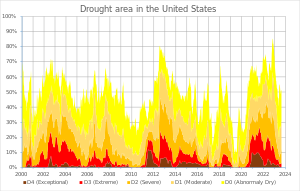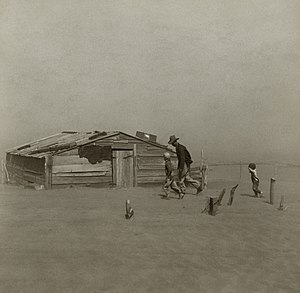

The United States' contiguous western and especially southwestern region has experienced widespread drought since about year 2000.[1][2] Below normal precipitation leads to drought, and is caused by an above average persistence of high pressure over the affected area. Changes in the track of extratropical cyclones, which can occur during climate cycles such as the El Niño-Southern Oscillation, or ENSO, as well as the North Atlantic Oscillation, Pacific Decadal Oscillation, and Atlantic multidecadal oscillation, modulate which areas are more prone to drought. Increased drought frequency and severity is also expected to be one of the effects of global warming.
Drought having an acute economic impact in the history of the United States occurred during the 1930s and 1940s, periods of time known as 'Dust Bowl' years where relief and health agencies became overburdened and many local community banks had to close.[3] The event also led to significant changes in farming practices emphasizing soil conservation and water resource management, inspired further growth in U.S. water storage and delivery infrastructure as part of the New Deal, and influenced other social changes.
Furthermore, global La Niña meteorological events are generally associated with drier and hotter conditions and further exacerbation of droughts in California and the Southwestern and to some extent Southeastern United States. Meteorological scientists have observed that La Niñas have become more frequent over time.[4]
- ^ Krajick, Kevin (2020-04-16). "Climate-driven megadrought is emerging in western US, study says". phys.org.
- ^ Williams, A. Park; et al. (2020-04-17). "Large contribution from anthropogenic warming to an emerging North American megadrought". Science. 368 (6488): 314–318. Bibcode:2020Sci...368..314W. doi:10.1126/science.aaz9600. PMID 32299953. S2CID 215789824.
- ^ Egan, Timothy (2005). "Drought: The Dust Bowl". National Drought Mitigation Center, University of Nebraska-Lincoln. Retrieved 2015-08-14.
- ^ Seth Borenstein, Associated Press science writer (May 28, 2022). "Weather's unwanted guest: Nasty La Niña keeps popping up". 9news.com. Retrieved June 4, 2022.
Scientists are noticing that in the past 25 years the world seems to be getting more La Niñas than it used to…